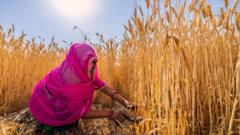As India experiences an early summer, farmers and manufacturers are grappling with the implications of rising temperatures on both production and economic stability. In Ludhiana, Nitin Goel, a clothing manufacturer, reveals the struggle his family-owned business has faced in adapting to shortening winters. "We’ve had to start making t-shirts instead of sweaters," he confides, noting a 10% drop in sales this season alone. The shifts in temperature are not only disrupting traditional retail cycles but also forcing companies to rethink long-standing business models, with retailers hesitant to honor even confirmed orders due to soaring temperatures.
The Indian Meteorological Department reported February 2023 as the hottest in 125 years, with abnormal temperature increases expected to persist across the country. This change in climate patterns is heralding anxiety not just in the textile sector but also among farmers across India, particularly in Devgad, a hub for Alphonso mangoes. Farmer Vidyadhar Joshi anticipates only 30% of typical yield this year, attributing the loss to extensive heat, increased irrigation costs, and labor shortages.
The heat wave is extending beyond mangoes, threatening staple crops such as wheat and chickpeas. Despite reassurances from the agriculture minister of a bumper wheat harvest, independent experts caution that yield reductions due to heat could prompt India to rely on costly imports. Already, reservoir levels in northern India have plummeted to 28% capacity, raising concerns over water availability for agriculture.
Economists fear that the rising temperatures may not only push food prices up, affecting inflation targets set by the central bank, but could also disrupt the economic recovery witnessed in rural consumption. Think tanks emphasize the urgent need for strategic interventions, including improved weather forecasting, agricultural insurance, and adaptation of cropping calendars to mitigate the effects of climate change. Without such actions, India faces a precarious future adversely impacted by heatwaves, with potential consequences for both life and economic health.






















